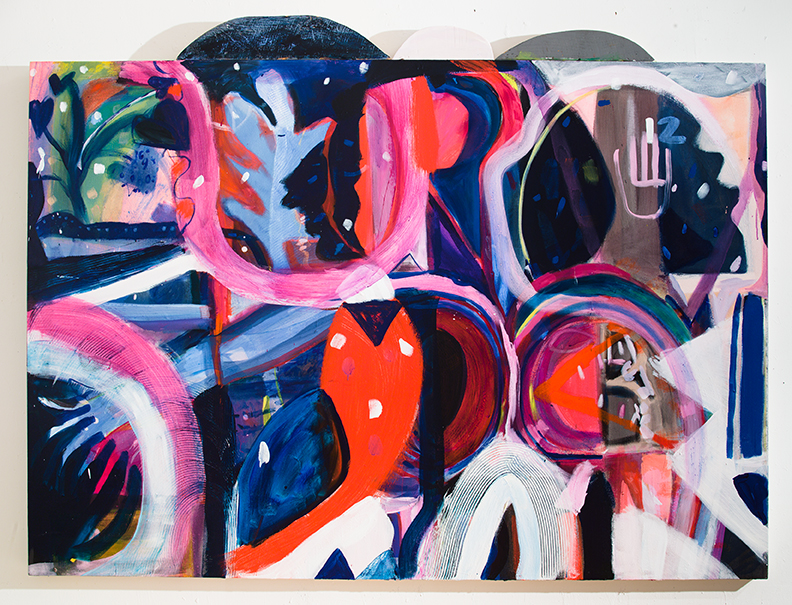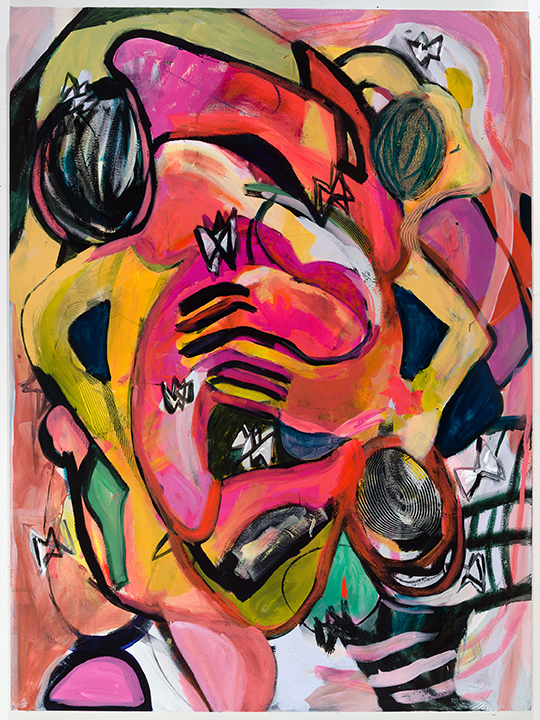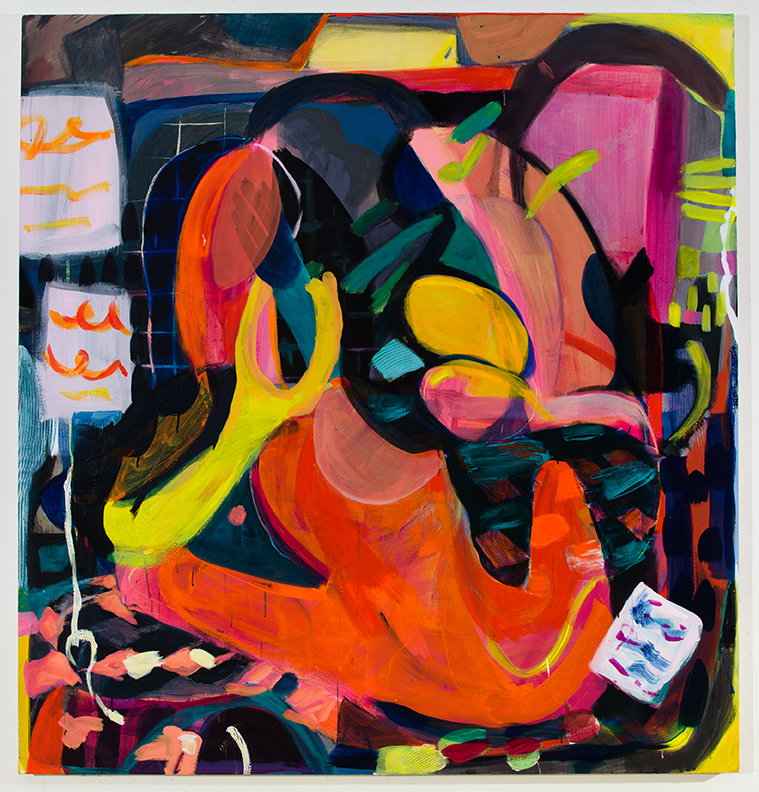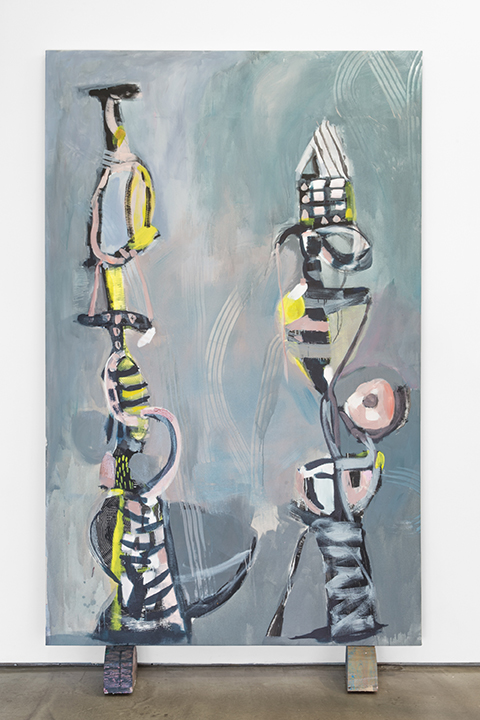Interview: Emily Noelle Lambert in Greenpoint
Posted on November 8, 2015
[Image: Emily Noelle Lambert, Back in, 2015, acrylic on canvas with wood, 86 x 60 inches.]
Contributed by Rob Kaiser-Schatzlein / Emily Noelle Lambert‘s recent paintings are large abstracts rendered in vivid acrylic paint. On display in “Ideé Fixe,” her solo show at Denny Gallery, through November 15th, they vary in line, brush size, color palette, shape, subject matter; whatever is a limiting factor in one painting (say, only using vivid colors), is illuminated inversely by it’s absence in the next (say, grays, that are honestly still pretty vivid). The final surfaces have some scraping marks, made with a raked ceramists tool or dry brushes, but very little squeegee action. Lambert rarely blends the paint once it is applied to the canvas.
One of the benefits of acrylic paint is its quick drying time, allowing each application of color, no matter how transparent or opaque, to look distinct, unmuddied, and decisive. Quick drying also means quick texture, and the surface will forever bear the history of previous attempts. Flat areas of color highlight previous decisions, revealing that Lambert is (and isn’t) all about color. For all the problem solving that happens on the canvas, the paint is thin and the canvas remains flat-looking. The flatness is reinforced by the commanding shapes that dominate the canvas by the foot, not the inch. Characteristically uncharacteristic, one painting has the number twelve written on it.
I met up with Emily at her Greenpoint studio to talk about her work.
[Image: Emily Noelle Lambert, Butterflies, 2015, acrylic on canvas, 70 x 58 inches.]
Rob Kaiser-Schatzlein: I was worried you wouldn’t have anything here, because our show, recently opened, but you do have a few things in the studio.
Emily Noelle Lambert: What’s happening now is I’m just clearing out space, since I have less work in here. I unwrapped and unrolled some older paintings like this one, from, gosh, I don’t even know when, maybe two thousand…ten?
RKS: Is this the most recent painting you’ve done? [she has just pulled out a new painting Butterflies that is the same vintage as the paintings in her current show]
ENL: The most recent painting is in the show, it was after this one. It was the piece Duo. I began the recent work for this show thinking about the figure and ways that the movement of the figure becomes confusing. I teach figure drawing at Fordham, so I get to see the magic of the body continually moving and changing and seeing it in ways you wouldn’t have expected. I started doing a lot of small ink drawings thinking about abstracting the figure so that it broke down in different ways. It was really happening as I was doing this intensive yoga teacher training class. Which I was taking to just understand yoga better.
RKS: Not to become a yoga teacher?
ENL: No, I had been practicing since I was in college in the mid-nineties. It was thinking “Wow, I could get better at doing this.” During the training, I was making a lot of drawings and just doing things like this. [she’s setting pen and ink sketches of figures on the ground, some with color and some just lines] Thinking about the body moving in space.
RKS: So you were doing a bunch of paintings for this show and you started with sketches, or something like that?
ENL: This was just the stuff that was in my mind, and I started these about a year ago. I started working on these paintings around February or March. This was just the build up towards that work.
RKS: Is this stuff a continual process, where you pull ideas from for larger work?
ENL: When I started the drawings, it was me trying to run through a bunch of ideas in a more rapid way, with the India ink on paper. The paintings are built and made so intuitively: I start, respond, put color down, then respond to the color. Some of these I started by drawing with black gesso, then laying in color and building up in that way. They happen free form.
RKS: You aren’t copying the sketches, but you are developing them as a warm-up?
ENL: Or developing the language, the shape, the muscle memory. Then I bring the fluidity into that and into the canvas. What has happened with these is that a lot of these shapes and forms from the sketches ended up coming into these wood cut-outs I was also making. I tried a bunch of smaller scale versions of this painting in particular.
RKS: The first stages of the painting process, the sketching with the black gesso, that’s its own thing?
ENL: It kind of becomes its own thing. This one [Butterflies] is knots of figures. There’s one painting in the show that is called Open and Close that has two figures in it, in sort of a circular formation. That’s related.
[Image: Emily Noelle Lambert, Open and Close, 2015, acrylic on canvas, 72 x 68 inches.]
RKS: So your paintings are not based on a session of figure drawing?
ENL: My early work was a lot of figure, then I left that and now I have come back. It’s always in there, even with the scale. And the sculptural pieces too, even the size of the painting is very human scale.
RKS: Are there any other materials I wouldn’t notice?
ENL: Not really. I studied oil painting and switched over to acrylic about half way through grad school, about when I started to work larger and put in more layers. Also when I wanted to white whole sections out and paint on top of it. But some of these smaller ones I’ll go back in with oil.
I use Guerra paint, they have so many great pigments. It’s a store in the East Village. They make commercial pigment and a whole bunch of other different kinds of mediums, flexible mediums from very thick to opaque. I use very shiny mediums to very flat ones, and it’s a great adhesive. I use their Ultra Light to stick all these other elements to the canvas.
RKS: Are your paintings all separate or do they refer to each other?
ENL: Oh, they all definitely refer to each other. Some are in the different families. I’ve been cutting up old canvases and attaching them together. This one is with pieces of driftwood I made at the Albee Foundation out in Montauk. Some are very silly and humorous. [She is moving throughout her studio showing me many examples of different types of work she’s done recently in the past]
RKS: What is this comb texture in your work? A lathe?
ENL: It’s this rubber thing that you can get at Dick Blick.
RKS: Oh, that’s for clay or something?
ENL: Yeah a ceramist tool.
RKS: Do you stretch a bunch of canvases at once?
ENL: For this series I did stretch a bunch and started that way. But other pieces, like Duo, I unrolled a big piece of canvas and worked on it unstretched. That’s one of the questions I’m bringing up for myself as I’m preparing new paintings. The thing with a show is that so many other questions come about, seeing the work and getting to step back and separate. Now I’m questioning what it is to work within the edges of the canvas and what is it to have an expansive space or field. So the next thing I’m interested in doing in here, which I have done before, is stretch really large onto the walls and set up parameters for myself, but let those be parameters I can move outside of so that I’m not constrained. That’s the problem with the canvas is that I always want to swell to the edge. Some of those pieces have wooden appendages or additions to them because I am wanting to expand out. There’s a few in the show that have these kind of additional pieces.
RKS: How do you decide how many to stretch at a time?
ENL: I don’t really know exactly how many paintings I stretched. Maybe ten, seven, eight paintings? I don’t remember how many I started. There are some back here that are still ready to be worked on. The advantage to working on the stretched canvases is that I can hide them from myself and put them away. It prevents me from just working and working and working. Taking down the unstretched canvas and rolling it up can get pretty cumbersome. In this space it’s feasible, but I’d rather not.
RKS: You’re not doing gesso right?
ENL: I often start with raw canvas and just paint right into it. And because I’m working with acrylic, for the most part they’ll shrink up or size up. Or I’ll water down the acrylic with a little bit of medium and color and paint on them that way.
RKS: There’s no raw canvas at the end though?
ENL: No generally the canvas is gone. [laughs]
RKS: Yeah, you have multiple drafts in each work? Or you white-out certain parts?
ENL: Well, I white out and I black out. Generally not the whole thing. This part here [points to an old painting with a big white triangle in the bottom half] is a white out… and there’s a blueing-out [points to another section on the painting]. In the show, one of the paintings called Back In I was working along with that and kind of felt like it got too dense and too set on maintaining the original imagery that was the impetus for the whole painting, which was two figures standing back to back in front of this little compartmentalized interior/exterior space. I had a whole narrative about what was going on with these figures, then there was this exploding-butterfly-heart area thing. But it wasn’t working, so I tried to ruthlessly cut-in with white forms, to bring in space and air. I’ve been working with the sculptures, which are big chunks of wood, as shape and form. They’re big chunks of color and form in a solid way. So in the painting it felt like there were just too many little things happening, and I want this meaty, heavy sense of color. So I laid in these heavy shapes in there, and then somehow it did bring air and space back in there. It still feels a little claustrophobic, and that’s the thing I am hoping I’ll figure out as I move on.
[Image: Emily Noelle Lambert, Violet, 2015, acrylic on canvas with wood, 30 x 28 inches.]
RKS: With that painting?
ENL: No it’s done, it’s in the show. It’s done for now, right? But that’s where my head is wanting to go, to think about that more. That’s about stopping sooner and putting away and coming back into it.
RKS: How do you know when to stop?
ENL: I think stepping away is an important thing.
RKS: Literally, or figuratively?
ENL: Literally, like putting them away. I usually have like five paintings going at once, so it’s easy to rotate in and rotate out. Doing that, I can see them fresh when I take them back out. But when I am really working on it I just want to keep going at it.
RKS: In this one in the studio, how did you know when you were done?
ENL: I don’t know for this one, it just felt like the thought of it was complete. The thing I was going for, these swirling forms and some questions left unanswered and some movement.
RKS: It had a high enough percentage of what you are going for?
ENL: Yeah, it is kind of an amazing thing. With the cutting back in I just felt like it wouldn’t come together.
RKS: Since you’re not working from a reference, you have an image in your head that is what you are going for and it sounds like it is clearly articulate in your head, do you feel that way?
ENL: There’s this great Adrienne Rich quote “What I’m going for is the wreck, not the story of the wreck”
RKS: What do you think that means?
ENL: Let it be the wreck of the painting. Tumbling and finding my way through it. Wondering what is the thing I’m chasing after, what is the thing I want. Including the energy and tumult and joy and fear and longing and all this desire. All those things tossed in there and still dealing with color and dealing with the edges of the painting. And in the making of the painting is all of that stuff, is the story of the painting. Letting things be and losing and finding and negating and building.
RKS: You start with just enough to start painting, and then you find problems needing resolution in there.
ENL: That’s what I think these drawings were about. I’m processing all that stuff in the drawings.
RKS: You have this abstract picture of forms and ideas in your head, and then you do this procedure and it’s translating it into something?
ENL: Procedure sounds like weird word to use, it sounds to me like a such formulaic step.
RKS: Of course, I just meant you’re doing something.
ENL: Right, I’m working. And then at some point setting up limitations. Several of those paintings I started being like “I’m only going to work with these colors” [she has a page in a sketchbook with four color blobs and they are labelled]
RKS: So you have a book where you keep these limitations?
ENL: No, not always. That’s the thing, there’s no rhyme or reason to any of this unfortunately. It would probably be smarter if there was. For a couple of the paintings I was trying to do that but for the other ones I had a smaller set where I was trying to give myself some limits. But then it’s always about pushing against those.
RKS: But it’s not a free-for-all.
ENL: Yeah.
RKS: Can you think of another set of limitations that may have helped you?
ENL: Yeah the painting in the show, Duo, I was really trying to stay within these colors of blue-grays, pink, and yellow. And to keep it as a painting of the sculpture, figuratively. It felt like a thin line to walk on, not painting over the whole thing, not adding in more, or more color. There are a few subtle variations within the blue-grays, then there are some different pinks. Even adding in that pink I was like, “let’s try to keep it a quieter palette.” Which is funny, I was just having a conversation with someone today about the palette and there is this electric, vibrant color thing going on in all the other paintings and then Duo was so muted. Something about the Greenpoint studio/urban city space, has me wanting all this color to work with. And that gray painting was made up in Vermont in August, where I was surrounded by greenery and all this color.
[Image: Emily Noelle Lambert, Duo, 2015, acrylic on canvas with wood, 109 x 60 inches.]
RKS: It allowed you to do something boring color-wise.
ENL: Right, there is plenty color outside, so in the studio I didn’t need it.
RKS: When is the best time for you to work?
ENL: I love a long day in the studio.
RKS: How long?
ENL: I like to get here in the morning about 9 or 10, I have a lot of energy in the morning but there is also a kind of sit and plan, and wait and look. I come in and drink coffee, and hang, look. Then it is: breathe in, look at everything, and jump in. Obviously some stops and starts and snacking. Then around four, I get a little sleepy, go outside go for a walk, come back in. You know, it doesn’t feel like it’s a solid block, because I don’t know what the next step is gonna be, so I work until I get where I don’t know what to do anymore, and then I stop, come back in later. It feels like constant problem-solving in these paintings.
RKS: When you say stop, do you mean go home, or just go do something else for a while?
ENL: Yeah, either way. I’m working sometimes and it is seven, eight, eight thirty, and I start thinking, “Gotta get home”, and then the answer comes quickly, like it had enough time to sit and gel. That’s specific to the paintings.
RKS: You don’t work past eight or nine?
ENL: Depends, sometimes I’ll work past eleven or twelve. I teach, at Parsons, two early mornings a week. So if it’s been a long day, sometimes it’s hard to stay late. But if it’s mid-week and I don’t have to be up at six in the morning it’s easier to stay.
RKS: You take the train?
ENL: I bike, or there is a bus. Or I walk. It’s a pretty straight shot home.
RKS: How long do your paintings take? Six paintings from February until now?
ENL: Yeah about, plus I probably made more. I’ll do five or six at once, and then a bunch of little paintings on the side. I’ve noticed this thing: the one painting that I’m really focused on gets all of my attention, and yet there are these offshoots. It’s like I’m sawing away at it and the sawdust kind of scatters off and sometimes that debris ends up being something more interesting. It’s like the main piece I’m working on becomes the sacrificial lamb for the fresher, lighter things that happen on the side that are given a different set of attention.
RKS: Is that what these are? [wall of little paintings of varying material and subject matter]
ENL: Yeah, but one of those is five years old, they’re not all recent. I was looking through things, and that one [a painted grid of colors, maybe 30 x 22 inches each squares very loose and approximately 6 x 6 inches] that’s what I was thinking about in terms of palette and this show. I was looking at color and blocking it out in that way. It’s like building with color, there is something that becomes sculptural about that. I don’t remember exactly what I was doing there.
RKS: Do you have a favorite tactile experience in painting?
ENL: I guess I’m feeling like it’s all tactile and that the tactile is a big part of it for me. I’m kind of scratching in to some of the paint, I’m wiping it away. With the sculptural pieces, sanding them down. Like these sculptures I made from old barn wood, I cut out these shapes and have been using them for a series of paintings as stencils [the pieces of wood are maybe seven feet tall, one and half across, and three inches deep, weighs maybe fifty pounds, with a long shape cut out of the center] They kind of look like a figure head standing [laughing]. The head is down here and the legs are going up, but they’re also sensual forms. I don’t know if there is a specific tactile thing I like better than any other.
RKS: It sounds like you like it all, and that’s very important to your work, that you like it.
ENL: Isn’t that how everybody does it?
RKS: Well, no, but you probably don’t realize it because you aren’t other people.
ENL: Yeah, the parts I don’t really like are what’s going on right now in here: reorganizing and making space. And trying to deal with the fact that I make big work. It’s true, I adore the work. I also know that there are times when I am not enjoying it. I started making sculpture because I got to a place in painting where I felt so burdened by it. I was not enjoying it, and was struggling with the figure; trying to get this lightness–to give this emotive sense to the figures. I wanted to figure out how to have a sense of fluidity and motion, and I was really laboring these faces to get that essence.
During this period, my studio neighbor, who was a costume designer, died. While her family was getting rid of all the costumes and clothing, I made friends with them. They would scream “Emily! Doll! Get over here we’ve got something for you!” They would give me these beautiful old dress and bags and slips, and like “Here’s some fur!” and hand me chunks of gorilla fur. Then they gave me this whole stack of mannequin heads; coincidentally I was making these paintings of stacked heads. Also, I was working for the Guggenheim Museum in the public schoolsmaking plaster sculptures out of recycled stuff with little kids. I came into the studio one day and it dawned on me to make sculptures out of the mannequin heads. So I started making plaster forms and taking five gallon buckets of paint and making this whole body of work from that. It was so fun, and made me feel like “What am I doing? What’s happening? This is amazing.” I started wondering why I wasn’t feeling that way when I was painting, what was the point if I was going to be spending all this time in the studio by myself and not spending money on a couch and whatever else, I better be enjoying this. So I started putting more things on the canvas and building it that way. That felt like a guiding point, for when I get bored I try to find what happens when I do different things. I mean, I have plenty of disasters, I don’t know where they’re all going.
RKS: That explains a lot of the byproduct work too, because you’ll make things just because you enjoy it whether or not it fits into your schema.
ENL: Yeah but I really want to figure it out though. Is it that I just like doing it or is it that I’m chasing after something, looking for something? Looking to make questions for myself. Is that enough to just like it? A quote I think about a lot by D.H. Lawrence “It’s not doing what you like, but doing what your deepest self likes, and that takes some diving” [She has the gist a hundred percent correct, this is the full quote: “The moment you can do just what you like, there is nothing you care about doing. Men are only free when they are doing what the deepest self likes. And there is getting down to the deepest self! It takes some diving”] How you find your way through it.
RKS: The foundation of art making has to be the enjoyment of the process. People who don’t find that enjoyment usually don’t continue making art.
ENL: Yeah, why would you do it. When I enjoy the work is when I can feel fortunate about what I’m doing





